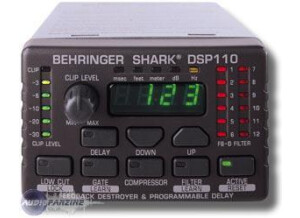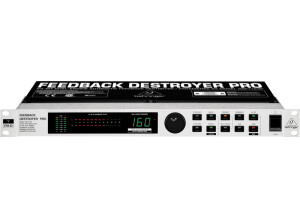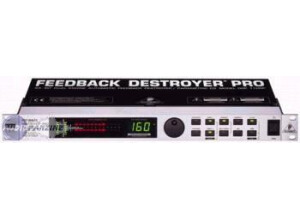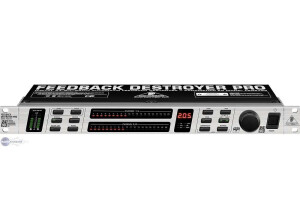Tech. sheet
- Manufacturer: Behringer
- Model: SHARK FBQ100
- Category: Feedback suppression processors
- Package weight:1.3 kg
- Other names:shark fbq100, sharkfbq100, shark fbq 100, fbq100, fbq 100, FBQ100, FBQ 100
We have no technical specifications for this product
but your help will be much welcomed
»
User reviews
5.0/5(2 reviews)
5
50 %
4
3
2
1
Not convinced
Published on 01/17/14 at 15:34 (This content has been automatically translated from French)Firstly I must say that I am interested in only the anti-feedback function and therefore it is the one I most thorough. I expected a lot of this anti-feedback. After several back and forth between reading the instructions and setting the device, I finally understand how it works.
We can not say it does not work, you can see the device, identify and eliminate the different frequencies of feedback. But ultimately we do not win much comfort and it does not push the level or microphone sensitivity so really significant. Finally playing on the position and returns the microphone, you get almost the same result. But this is not the worst, I see a resonance as if there was a reverb and worse,...…
We can not say it does not work, you can see the device, identify and eliminate the different frequencies of feedback. But ultimately we do not win much comfort and it does not push the level or microphone sensitivity so really significant. Finally playing on the position and returns the microphone, you get almost the same result. But this is not the worst, I see a resonance as if there was a reverb and worse,...…
Read more
Firstly I must say that I am interested in only the anti-feedback function and therefore it is the one I most thorough. I expected a lot of this anti-feedback. After several back and forth between reading the instructions and setting the device, I finally understand how it works.
We can not say it does not work, you can see the device, identify and eliminate the different frequencies of feedback. But ultimately we do not win much comfort and it does not push the level or microphone sensitivity so really significant. Finally playing on the position and returns the microphone, you get almost the same result. But this is not the worst, I see a resonance as if there was a reverb and worse, the sound is very metallic whereas bypassing the SHARK, the sound is pure and without resonance.
Maybe this is the micro I've tried, a SM 58 and SM 57. It seems to be preferable to use a condenser microphone, but I do not know of any brand and any model which would be best suited. I actually beeps in a group, for services in room, kind of celebrations. Electroacoustic instruments pose no problems for me, micro songs either, but it is complicated or is when to take the overall sound of several singers. It is unthinkable to have to have as many microphones as singers, so I wanted to take all without feedback in return, knowing that there onstage singers and musician (Flute, accordion, guitar, percussion) and worse, violins feedback for a yes or a no, even with piezo pellets. Anyway I can get with the violins the same problem with singers because in some configurations there are 6! so it should come to take the entire console violin. This is the return that cause problems, but it is essential, because the room acoustics or we play is abysmal and it is impossible to make music when the sound of the room back to the scene with a big gap .. ..
I happened to play in modern rooms, or the sound is perfectly integrated, This is great, we donut in sound and there is no feedback ....
In short, if someone could give me advice, I would be very interested. SHARK this is probably a good product, but it is not at all obvious to implement.
Can also be Berhinger it should do the work of teaching, so that customers are more proficient in the implementation of this unit.
We can not say it does not work, you can see the device, identify and eliminate the different frequencies of feedback. But ultimately we do not win much comfort and it does not push the level or microphone sensitivity so really significant. Finally playing on the position and returns the microphone, you get almost the same result. But this is not the worst, I see a resonance as if there was a reverb and worse, the sound is very metallic whereas bypassing the SHARK, the sound is pure and without resonance.
Maybe this is the micro I've tried, a SM 58 and SM 57. It seems to be preferable to use a condenser microphone, but I do not know of any brand and any model which would be best suited. I actually beeps in a group, for services in room, kind of celebrations. Electroacoustic instruments pose no problems for me, micro songs either, but it is complicated or is when to take the overall sound of several singers. It is unthinkable to have to have as many microphones as singers, so I wanted to take all without feedback in return, knowing that there onstage singers and musician (Flute, accordion, guitar, percussion) and worse, violins feedback for a yes or a no, even with piezo pellets. Anyway I can get with the violins the same problem with singers because in some configurations there are 6! so it should come to take the entire console violin. This is the return that cause problems, but it is essential, because the room acoustics or we play is abysmal and it is impossible to make music when the sound of the room back to the scene with a big gap .. ..
I happened to play in modern rooms, or the sound is perfectly integrated, This is great, we donut in sound and there is no feedback ....
In short, if someone could give me advice, I would be very interested. SHARK this is probably a good product, but it is not at all obvious to implement.
Can also be Berhinger it should do the work of teaching, so that customers are more proficient in the implementation of this unit.
See less
20
»
Very effective and comprehensive
Published on 09/15/12 at 12:46 (This content has been automatically translated from French)Automatic feedback suppressor.
Has a selectable low-pass filter, a "Gate" parameterized, compressor slightly customizable, and configurable feedback suppressor.
Button "on / off" sorely feel his absence.
The manual offers to go on the internet to find a more complete version. It is not too early either ...
But it is really the only point on which we can bitch!
Explanations of the instructions are understandable. It reveals the rather full settings, and automatic functions.
Reread once again while testing the vehicle, any shadows lighten quickly.
There is a setting for clipping the input if it is set to type "Mic".
DELAY: Sets the time delay depending on the distance...…
Has a selectable low-pass filter, a "Gate" parameterized, compressor slightly customizable, and configurable feedback suppressor.
Button "on / off" sorely feel his absence.
The manual offers to go on the internet to find a more complete version. It is not too early either ...
But it is really the only point on which we can bitch!
Explanations of the instructions are understandable. It reveals the rather full settings, and automatic functions.
Reread once again while testing the vehicle, any shadows lighten quickly.
There is a setting for clipping the input if it is set to type "Mic".
DELAY: Sets the time delay depending on the distance...…
Read more
Automatic feedback suppressor.
Has a selectable low-pass filter, a "Gate" parameterized, compressor slightly customizable, and configurable feedback suppressor.
Button "on / off" sorely feel his absence.
The manual offers to go on the internet to find a more complete version. It is not too early either ...
But it is really the only point on which we can bitch!
Explanations of the instructions are understandable. It reveals the rather full settings, and automatic functions.
Reread once again while testing the vehicle, any shadows lighten quickly.
There is a setting for clipping the input if it is set to type "Mic".
DELAY: Sets the time delay depending on the distance of the speakers output. Is set in ms, in feet or meters to 800 meters around!
LOW CUT: adjustable from 20 to 150Hz. If you keep the button pressed, it triggers lock all keys settings.
GATE: Sets the filter threshold from -96 and -44 dB. Keeping the button pressed, it engages the LEARN function is a function that automatically Gate (learning level).
COMPRESSOR: Compressor basic. You can set the "intensity" (threshold + ratio) compression between 0 and 100, and ATTACK / RELEASE AT THE SAME TIME, between 10 and 1000 ms. Therefore, only two settings: one for "TRESHOLD / RATIO" = intensity, and the second parameter which simultaneously ATTACK and RELEASE with the same value! So enough amber ...
FILTER: has two parameters, one to adjust the sensitivity of the sensor feedback from 1 to 100, the other to adjust the importance of reducing offending frequency-3dB to-48dB. Keeping this button pressed, it engages the automatic frequency search with parasites can determine the number of filters to make it "fixed. Typically 9, but can go up to 12.
Specifically, the device will default to 9 determining anti-feedback filters fixed, leaving three open filters dynamically to intervene on his appearance at the new frequency noise. But you can change this setting and to determine more or less fixed filters.
FILTER LEARN function is useful before starting a presstation audio: it generates a range of frequencies at low volume (-18dB) to track previously unwanted frequencies. This process, although at low volume, regardless still be audible and therefore, it is préféralbe use the function prior to the performance itself.
ACTIVE: adctivant in this function, filters not yet assigned to a frequency remain in research. This mode is enabled by default. Keeping the button pressed, it resets all filters.
There are two inputs, XLR and 1/4 "balanced, and two outputs, XLR and 1/4" balanced. There is also a phantom power.
A positive point is that the camera memorizes the use of filters to another, despite the power failure.
Construction is OK. Nice, very rammassée. The body is metallic. The machine seems to be relatively strong ...
The external power supply is provided.
I did a test "radical" with electro-acoustic not only connected to the internal active preamp, but taken together externally by a Rode NT3.
The two channels are mixed together by Headway EDB-1, then sending the signal through the XLR DI out to a preamp SM Pro Audio TC01 (including the original lamp, infamous, was changed to an Electro Harmonix).
The TC01 sends the signal to the Shark FBQ100, and it finally sends the signal in the second channel of my Fishman Loudbox Artist Acoustic Combo Pro-LBX-600 120w.
All-NT3-guitar combo is in a circle of less than 70 cm in diameter and without being directed towards the center, facing the elements in one way or another. The microphone is directed to the guitar, or + - 20cm, almost parallel with the combo, which also + or - in front of the guitar, fifty cm.
the room itself is very small.
In principle, in this configuration, this "feedback" at low volume, having already tested under conditions even less excessive. No way to escape!
Moreover, the start has been clearly demonstrated. But it has also demonstrated the effectiveness of the system ...
So I have not used the "FILTER LEARN" and I left the FBQ100 in simple mode adtif the outset, seeking Spurious while I play guitar.
A low volume, in seconds, 5 or 6 frequencies are killed and fixed, allowing me to boost the volume to a medium-high level, never achieved before in such a configuration.
New feedback frequencies born then, and are also killed and fixed fairly quickly, in total up to 8 or 9 to mount the volume even higher, so high level.
Climbing at a very high volume of new frequencies apparraissent feedback yet dynamically and are killed by the 3 remaining active filters (not set, but still looking). But it's still audible, as these frequencies must be systematically redefined. I could also set the system to use as fixed filters 12 filters, which permaittrait perhaps better stabilize such a volume?
Finally, for a truly high volume, either the frequency is still able to move, despite the FBQ100, given the unstable configuration that is used voluntarily.
In summary, the efficiency of the device is really impressive, even if it is not absolute, which is perfectly normal!
Hats off!
I just tested the compressor.
It is quickly noticeable, even already at level 5!
At 10, the sound of my guitar was not bad transformed! Admittedly, I left the setting ATTACK / RELEASE in very short, but an intensity of 10 out of 100, it was still very noticeable! That said, it is true that the compressor TC01 was also in action "light", which could explain the "bite" of a superposition FBQ100 compressors ...
I do further testing at this level to get a better idea of this feature.
I have not yet tested the GATE function, or the low-pass flter: this will be a future update.
Otherwise, the device provides no breath nor particularly distorts the original signal, according to my perception, even when 9 frequency filters are set.
I use it a few days ago. I have not tried other models.
What I like most is its incredibly efficient, and comprehensive functions and settings, even if the compressor is a little too basic. I also like its inputs and dual outputs, XLR and Jack.
I do not like the lack of "On / Off"! Product stupidly loses points because of it!
In summary, a great product that I propse to buy multiple copies to use different channels of microphones in a group setting. Certainly at least two, and perhaps three, or more as needed ...
It really is a component of the first utility that takes its main function brilliantly!
NB: I will update soon for functions LOW CUT GATE, and FILTER LEARN as soon as I have them better tested, and the compressor in other conditions.
Has a selectable low-pass filter, a "Gate" parameterized, compressor slightly customizable, and configurable feedback suppressor.
Button "on / off" sorely feel his absence.
The manual offers to go on the internet to find a more complete version. It is not too early either ...
But it is really the only point on which we can bitch!
Explanations of the instructions are understandable. It reveals the rather full settings, and automatic functions.
Reread once again while testing the vehicle, any shadows lighten quickly.
There is a setting for clipping the input if it is set to type "Mic".
DELAY: Sets the time delay depending on the distance of the speakers output. Is set in ms, in feet or meters to 800 meters around!
LOW CUT: adjustable from 20 to 150Hz. If you keep the button pressed, it triggers lock all keys settings.
GATE: Sets the filter threshold from -96 and -44 dB. Keeping the button pressed, it engages the LEARN function is a function that automatically Gate (learning level).
COMPRESSOR: Compressor basic. You can set the "intensity" (threshold + ratio) compression between 0 and 100, and ATTACK / RELEASE AT THE SAME TIME, between 10 and 1000 ms. Therefore, only two settings: one for "TRESHOLD / RATIO" = intensity, and the second parameter which simultaneously ATTACK and RELEASE with the same value! So enough amber ...
FILTER: has two parameters, one to adjust the sensitivity of the sensor feedback from 1 to 100, the other to adjust the importance of reducing offending frequency-3dB to-48dB. Keeping this button pressed, it engages the automatic frequency search with parasites can determine the number of filters to make it "fixed. Typically 9, but can go up to 12.
Specifically, the device will default to 9 determining anti-feedback filters fixed, leaving three open filters dynamically to intervene on his appearance at the new frequency noise. But you can change this setting and to determine more or less fixed filters.
FILTER LEARN function is useful before starting a presstation audio: it generates a range of frequencies at low volume (-18dB) to track previously unwanted frequencies. This process, although at low volume, regardless still be audible and therefore, it is préféralbe use the function prior to the performance itself.
ACTIVE: adctivant in this function, filters not yet assigned to a frequency remain in research. This mode is enabled by default. Keeping the button pressed, it resets all filters.
There are two inputs, XLR and 1/4 "balanced, and two outputs, XLR and 1/4" balanced. There is also a phantom power.
A positive point is that the camera memorizes the use of filters to another, despite the power failure.
Construction is OK. Nice, very rammassée. The body is metallic. The machine seems to be relatively strong ...
The external power supply is provided.
I did a test "radical" with electro-acoustic not only connected to the internal active preamp, but taken together externally by a Rode NT3.
The two channels are mixed together by Headway EDB-1, then sending the signal through the XLR DI out to a preamp SM Pro Audio TC01 (including the original lamp, infamous, was changed to an Electro Harmonix).
The TC01 sends the signal to the Shark FBQ100, and it finally sends the signal in the second channel of my Fishman Loudbox Artist Acoustic Combo Pro-LBX-600 120w.
All-NT3-guitar combo is in a circle of less than 70 cm in diameter and without being directed towards the center, facing the elements in one way or another. The microphone is directed to the guitar, or + - 20cm, almost parallel with the combo, which also + or - in front of the guitar, fifty cm.
the room itself is very small.
In principle, in this configuration, this "feedback" at low volume, having already tested under conditions even less excessive. No way to escape!
Moreover, the start has been clearly demonstrated. But it has also demonstrated the effectiveness of the system ...
So I have not used the "FILTER LEARN" and I left the FBQ100 in simple mode adtif the outset, seeking Spurious while I play guitar.
A low volume, in seconds, 5 or 6 frequencies are killed and fixed, allowing me to boost the volume to a medium-high level, never achieved before in such a configuration.
New feedback frequencies born then, and are also killed and fixed fairly quickly, in total up to 8 or 9 to mount the volume even higher, so high level.
Climbing at a very high volume of new frequencies apparraissent feedback yet dynamically and are killed by the 3 remaining active filters (not set, but still looking). But it's still audible, as these frequencies must be systematically redefined. I could also set the system to use as fixed filters 12 filters, which permaittrait perhaps better stabilize such a volume?
Finally, for a truly high volume, either the frequency is still able to move, despite the FBQ100, given the unstable configuration that is used voluntarily.
In summary, the efficiency of the device is really impressive, even if it is not absolute, which is perfectly normal!
Hats off!
I just tested the compressor.
It is quickly noticeable, even already at level 5!
At 10, the sound of my guitar was not bad transformed! Admittedly, I left the setting ATTACK / RELEASE in very short, but an intensity of 10 out of 100, it was still very noticeable! That said, it is true that the compressor TC01 was also in action "light", which could explain the "bite" of a superposition FBQ100 compressors ...
I do further testing at this level to get a better idea of this feature.
I have not yet tested the GATE function, or the low-pass flter: this will be a future update.
Otherwise, the device provides no breath nor particularly distorts the original signal, according to my perception, even when 9 frequency filters are set.
I use it a few days ago. I have not tried other models.
What I like most is its incredibly efficient, and comprehensive functions and settings, even if the compressor is a little too basic. I also like its inputs and dual outputs, XLR and Jack.
I do not like the lack of "On / Off"! Product stupidly loses points because of it!
In summary, a great product that I propse to buy multiple copies to use different channels of microphones in a group setting. Certainly at least two, and perhaps three, or more as needed ...
It really is a component of the first utility that takes its main function brilliantly!
NB: I will update soon for functions LOW CUT GATE, and FILTER LEARN as soon as I have them better tested, and the compressor in other conditions.
See less
170
»













